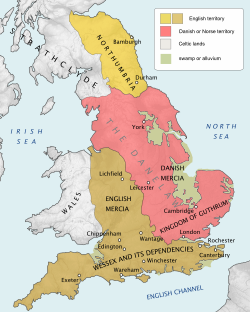This article should specify the language of its non-English content using {{ lang }} or {{ langx }}, {{ transliteration }} for transliterated languages, and {{ IPA }} for phonetic transcriptions, with an appropriate ISO 639 code. Wikipedia's multilingual support templates may also be used.(March 2023) |
Kingdom of Bernicia | |||||||||||||
|---|---|---|---|---|---|---|---|---|---|---|---|---|---|
| 6th century–654 | |||||||||||||
 | |||||||||||||
| Capital | Bamburgh | ||||||||||||
| Official languages | Northumbrian Old English | ||||||||||||
| Minority languages | Cumbric | ||||||||||||
| Religion | Anglo-Saxon paganism | ||||||||||||
| Government | Monarchy | ||||||||||||
| Historical era | Early Medieval | ||||||||||||
• Established | 6th century | ||||||||||||
• Shared crown with Deira | 604 | ||||||||||||
• merged with Deira | 654 | ||||||||||||
| |||||||||||||
| Today part of | United Kingdom | ||||||||||||
Bernicia (Old English : Bernice, Beornice) was an Anglo-Saxon kingdom established by Anglian settlers of the 6th century in what is now southeastern Scotland and North East England.
Contents
- Etymologies
- Political history and memory
- Kings of British Bryneich
- English Bernicia
- A forcibly united Northumbria
- Rump of Northumbria
- Kings of Bernicia
- Notes
- References
- Further reading
The Anglian territory of Bernicia was approximately equivalent to the modern English counties of Northumberland, Tyne and Wear, and Durham, as well as the Scottish counties of Berwickshire and East Lothian, stretching from the Forth to the Tees. In the early 7th century, it merged with its southern neighbour, Deira, to form the kingdom of Northumbria, and its borders subsequently expanded considerably.


